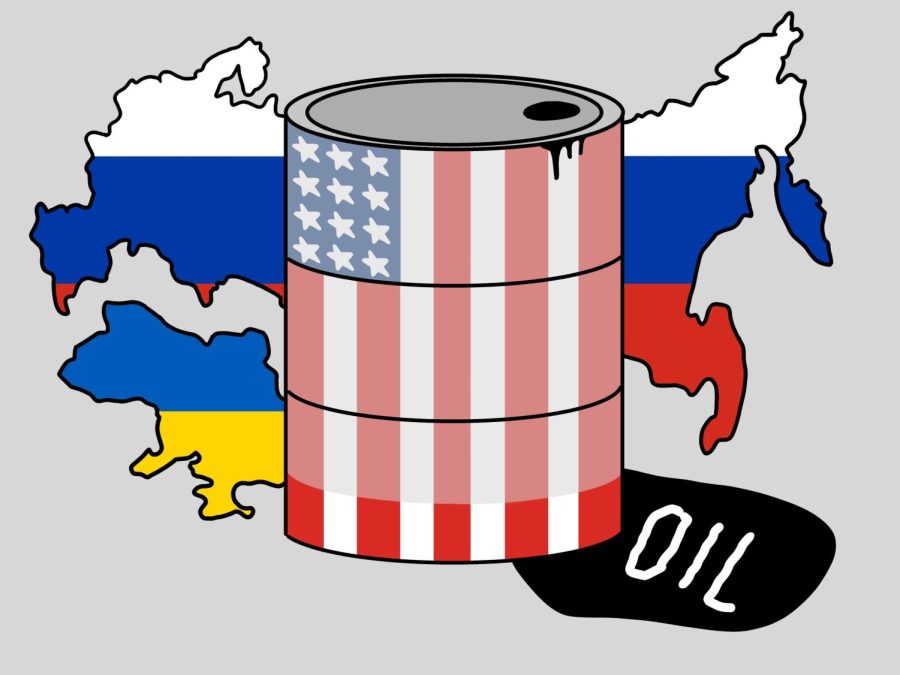An invasion of Ukraine has consequences for domestic markets
February 25, 2022
As a possible invasion of Ukraine by Russia becomes more imminent, the U.S. is experiencing effects on its domestic markets, with crude oil prices soaring amid inflation and supply chain problems.
Despite posting over 100,000 troops on its border with Ukraine, Russia has repeatedly denied plans to invade Ukraine, but this may be a tactic to push NATO away from creeping into Eastern Europe. Russian President Vladimir Putin approached Western governments, warning NATO to stop all military activity in Eastern Europe and to cut alliances with previous Soviet nation members.
Ignoring Putin’s demand, Biden promptly informed him that if Ukraine was invaded, he would slap economic sanctions against Russia and not allow the Nord Stream II gas pipeline — which connects Russia to Germany through Ukraine — to continue. The pipeline has since been canceled.
European Commission President Ursula von der Leyen said that if Russia invaded Ukraine, the country would be cut off from internal financial markets and be denied access to major exports, which are needed to modernize its economy.
Sanctions wouldn’t just impact energy markets but commodity markets. Russia is the biggest producer of aluminum in the world, producing 3.7 million metric tons of the metal— last year— and supplying over 5% of the world’s total aluminum demand. News of a possible invasion has skyrocketed the price of aluminum.
Russia is also a big producer of wheat, which could face possible sanctions from the West.
Historically, Russia has been the biggest provider of natural gas and oil to Europe, but despite growing global demand, Russia and other OPEC countries are not speeding up oil production. The possibility of sanctions against Russia will tighten the supply constraints and put many European countries in a tough position.
Domestic markets are also being impacted by this news. Although the U.S. is one of the largest producers of oil and natural gas, crude oil prices are set at a global level. As of Feb. 21, crude oil is priced at $93.10 per barrel.
The U.S. oil and natural gas market already took a hit in spring 2020 due to the COVID-19 pandemic, causing crude futures to turn negative.
Rising global oil prices have sped up oil production, giving incentive to drilling companies. The number of U.S. rigs drilling jumped by 22 on Feb. 11, which is the largest rise in the nation since 2018, according to oil field service firm Baker Hughes Co.
Inflation pressures already persist as money is being pumped into the economy to counter the pandemic’s impact on the markets. An imminent invasion could inflate the consumer price index since oil prices are a big factor in its calculations, while higher fuel costs are also expected to put pressure on companies’ profit margins.
“Chronic underperformance by OPEC+ in meetings its output targets and rising geopolitical tensions have propelled oil prices higher,” the International Energy Agency said in its February report, warning this trend will continue to the end of this year. “The global refining industry has underperformed relative to demand for the past six quarters.”
In January OPEC missed its set target by 900,000 barrels per day, in comparison to 790,000 barrels per day in December. Due to pressure from the pandemic, 14 of the 18 OPEC nations failed to meet their targets.
The IEA called for OPEC nations to pick up daily production of oil to meet global demand, but oil-producing Arab countries said OPEC should stick to its current goal of adding 400,000 barrels per day as per their agreement. Arab nations are also doing this to warn against placing sanctions on natural gas and oil sales on Russia and other European nations.
With the pandemic tapering off, COVID-19 restrictions easing and air travel expected to increase, the total global oil demand is expected to increase to around 100 million barrels per day, which is 3.2 million barrels more than last year. If Iranian sanctions are lifted, it may contribute 1.3 million barrels per day by the end of the year.
The major central banks, including the Federal Reserve, are expected to increase interest rates in the near future and this might be stalled if situations worsen.
While the United States imports 3% of its oil, it has prioritized shipping oil to South America, Asia and Europe due to attractive prices and its desire to be the leader in oil supply. This deters countries from relying heavily on Russian oil and natural gas.
For the first time, the U.S. was able to ship more oil to Europe than Russia does through pipelines last year. If Russia wants to be number one in oil exports again, it’s best for the country to steer away from U.S.-imposed sanctions by not invading Ukraine.







